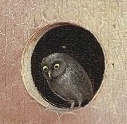








In her book The Secret Heresy of Hieronymus Bosch, 1995, 2002, Lynda Harris presents the case for Bosch being a Christian heretic, infused with some Cathar Manichaean zeal, who used his paintings to secretly advance Cathar ideas.
This book is full of "if this were so...", "one might assume...", "there is a good chance, then, that...", "it is most likely...", that is, it presents no firm evidence but merely a thin insubstantial tissue of fabricated speculation.
There is no evidence of Cathar influence in 's-Hertogenbosch and its environs in the late 15th century, and nothing to suggest that Bosch was a member of a secret cult. So in order to find some connection, Harris has to go on a fishing exhibition. She realises that some paintings of Bosch were recorded as being in Venice by 1521. So she makes the giant leap of suggesting Bosch had visited Venice and even perhaps painted these works in that city. She sees Venice as a hotbed of Cathar heresy, and that Bosch visited there in order to develop his secret heresy further. There is no proof, of course, that Bosch ever did visit Venice, so Harris goes fishing for some.
She assumes Bosch would have met the notable artists living and working in Venice at that time and may indeed have influenced these artists. So she finds a candidate for this in Giorgione, suggesting these as these two shared a common painting style "using light brush-strokes and paint delicate, wispy highlights on details such as waterfalls, embroideries or metals" they must have met and influenced one another. She also sees Bosch as meeting Leonardo da Vinci and even goes so far as to say "But Bosch did not just take influences from Leonardo. He also seems to have given some back." This is based on such thin evidence. The reason she needs us to accept this is to establish that Bosch had visited Venice. So she fishes for more "evidence". She finds a depiction of a Persian Philosopher in Giorgione's The Three Philosophers to be a portrait of Bosch with a beard and wearing Eastern dress.


The whole thing is such total nonsense, stretching rubbery interpretation well beyond its breaking point. "Could there be", note the ever present subjunctive, states Harris "any connection, for example, between their [Giorgione, Bosch and Leonardo] meeting in Venice, and the group of three thoughtful men depicted in Giorgione's Three Philosophers?" It is not difficult to answer this question for her. NO ! But she ploughs on disregarding.
She has to take us on a journey to Bosnia as this is the only place in the Europe of that period when there is any recorded Cathar influence during that late 15th early 16th century. We are presented with some photographs of what she calls Cathar tombstones (stecci). These have among other things carvings of stags and also herons. But wait! Bosch includes stags and herons in his paintings. Ah! it is obvious he was influenced by such primitive stone carving. He could not have thought to depict a stag or heron till he saw these. How can a person intelligent enough to be able to write a book, believe she can convince anyone with such nonsense?
In order to explain the lack of evidence for her thesis, at one point Harris states :
"We should not assume that where there are no records of Cathars, no Cathars existed."Really ! She obviously applies the logical rule of transposition (~R -> ~C) <-> (C -> R) in a way not recognised by logic. Logicians would say that the statement "if no records exist then no Cathars" is equivalent to saying "the existence of Cathars implies the existence of records". She is saying "if no records exist then no Cathars" is equivalent to saying "Cathars exist" (~R -> ~C) <-> C. Last time I checked propositional logic this was not so. This is like saying - the fact that there is no evidence of Polar bears in the Antarctic does not mean that they are not there. If you accept her logic then you can rewrite history in any way you want, as you don't need any evidence. She concludes:
"With luck and patience, a small group of Cathars could have lived undiscovered in 's-Hertogenbosch for years or even centuries..."I will advance a little theory of my own. Could it be that Linda Harris having read Fraenger's thesis which had Bosch as a member of a secret Adamite cult related to the Brethren of the Free Spirit, thought she might top this by bringing in the wonderfully obscure Cathars? Poor old Bosch, the master painter of 's-Hertogenbosch now reduced to the role of defending a heretical, cranky, belief system, that was rapidly dying out of existence. How can Harris, the master of the subjunctive, feel comfortable stealing his delightful creations from him and appropriate them as mere propoganda for a dualistic cult? Leave the poor man alone. Let his works speak for themselves.
"Once Bosch's art came into its own in Venice, he would have been able to produce an illustrated record which would preserve all the main tenets to Mitigated Catharism before it vanished completely..."
[His pictures] "depict the Cathar universe with all its heights and depths. The spirituality of Bosch, as well as his dualism and his Cathar message, are visible in every painting he produced."






